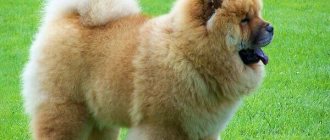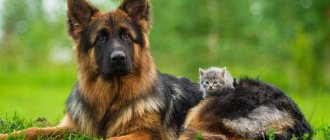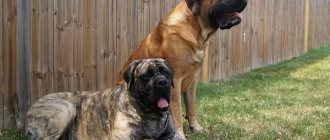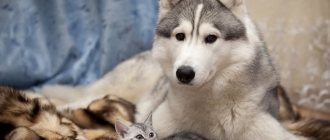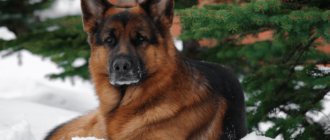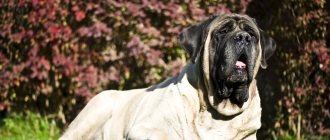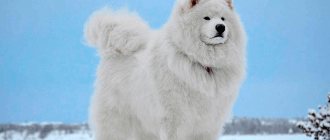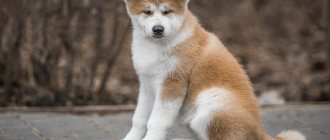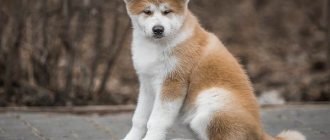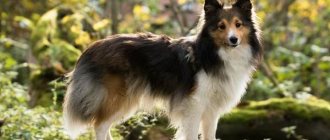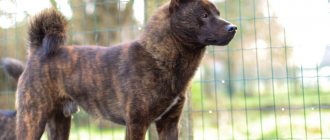One of the most ancient dog breeds from Asia. In particular, this breed comes from Northern China and Mongolia. The first mention of the breed appeared in the 11th century BC.
During the Han Dynasty, many clay figurines and paintings were made depicting this breed. Chow chow came to China from Tibet. From the very beginning, the dog was surrounded by honor. The monks believed that the chow-chow drove away evil spirits with its barking.
The Chinese used the Chow Chow as a working dog (hunting wolves, sables and pheasants, guarding and protecting homes). The dog's fur was used to make clothing.
For a long period of time, chow chow was unavailable to Europeans. The first mention of chow chow was brought to Europe by the famous Marco Polo, who spent a long time in China and Tibet.
The first dogs of this breed were brought to England on a merchant ship in 1830. Interest in chow-chow in England grew incredibly quickly.
In more recent times, the dog became a popular pet.
Description and features
In the course of long-term scientific work, it was precisely determined that the ancestors of the Chow Chow breed were Asian wolves. The dog changed over the centuries until breeders clearly decided on its standard.
Interesting fact! Europeans first learned about this wonderful animal thanks to the records of Marco Polo, the famous navigator. He spent a long time in China, where he noticed a huge and fluffy animal with the habits of a dog, but the appearance of a bear.
Previously, the attitude towards chow chow was different. The dog was idolized, high hopes were placed on it, and restraint was taught. Yes, as you already understood, its first owners were monks. They wanted high-breed individuals not to crossbreed with mongrels and ensure the preservation of the species.
The main feature of the dog is its unusual appearance. She has a very lush fur coat that serves as insulation, blue gums and narrow eyes, like an Asian's. It has many purposes: protection, hunting and companionship.
People from different continents take such a dog with them into the forest to give it the opportunity to show endurance and strength. He is agile and fast, so he easily catches up with small animals, such as hares. In everyday life he is a good watchman. He is characterized by responsibility and observation.
Always strives to protect members of its pack, while being indifferent or aggressive towards strangers. Experts say that previously, in some Asian countries, representatives of the breed in question were eaten. Their meat was considered a delicacy. Today no one treats such dogs as food.
For their owners, they are affectionate and devoted companion pets. They are not characterized by obsession and too violent expression of emotions. The Chow Chow is a restrained and consistent dog in its actions, inclined to trust its owner. He is naturally very strong, so he needs regular training to maintain his condition.
He treats household members with respect and love, but only if they also give him warm feelings in return. Loves to play with them, run, look for different objects. By nature he is a cheerful person.
Purpose
Initially, chow chows were used in fights. Then they retrained as guard dogs. For a short period of time, the Tibetans even went hunting with them. And at the same time, dog meat was supplied to the Emperor as a delicacy. Once in Europe, chows gained a reputation as companion dogs, and they were also kept to guard estates. Well, today majestic and proud mini-lions are positioned as an ornamental breed.
Breed standard
The Chow Chow dog has a truly lion-like appearance. Experts classify it as a medium breed. According to the standard, it should weigh from 22 to 30 kg. The height at the withers of an adult dog is from 45 to 52 cm. A small error is allowed in both height and weight.
He has an unusual not only appearance, but also his gait. The animal moves intermittently, heavily, as if walking on stilts. However, this does not stop him from radiating pride and self-confidence.
Important! The main sign of a high-breed Chow Chow is a blue or purple tongue.
The animal has an elongated rectangular body with strong bones. The paws are short, medium in thickness, and stand on pads. Placed close to each other, symmetrically. The abdomen is not sunken, the chest is poorly defined and does not protrude. The lumbar region is convex. The dog's tail lies in a ring on the lower back.
The animal's head is large, the skull is flat. The darkly pigmented muzzle is quite wide, with a powerful jaw. Individuals with light fur may have red markings in their mouths. The ears are small and very neat.
The dog's fur is hard to the touch, long and thick. It is also the same in length on all parts of the body, but on the neck it is as long as possible, up to 15 cm. The Chow Chow in the photo looks like a plush toy, it is large and very fluffy.
What do newborns look like in photos?
Newborn puppies are practically not adapted to the environment and are completely dependent on their mother. Babies have a dense body and a large head.
They sleep most of the time, suckle from their mother's milk and gain weight.
A puppy’s body temperature in the first 20 days of life is 33-36 degrees; during this period, babies cannot independently maintain body temperature and are not able to warm themselves.
And only on the 21st day the temperature rises to 36.5 - 38 degrees.
The weight of a chow chow is 2.8 - 3.8 kg, length - 18 - 22 cm . Puppies' eyes open 10-15 days after birth.
Kinds
Depending on the length of their fur, these bear dogs are divided into 2 types:
- Long-haired.
- Short-haired.
The fur of the former is approximately 5 cm longer. It is more lush and beautiful. There is guard hair. Above we examined the classic appearance of a representative of the breed. But, breeders brought out a related one - chow chow smooth. This dog is very similar to the Akita Inu, but only in body parameters.
Its fur density is the same as that of a classic representative of the breed. The smooth has an important difference - a smooth coat. You can also divide these dogs according to the shade of their fur. The most popular is red-red. Lighter and darker tones are acceptable, there are a lot of variations: lead, copper, gold, burgundy, red, etc.
Other shades of animal fur:
- Black.
- Brown.
- Beige.
- Red and cream.
- Blue/silver.
- Red-pink (very rare)
Main types of colors
Black
The most preferred is pure black without any extraneous shades. However, most Chow Chows of this color have lighter fur on the hind legs and tail.
Blue
It can be any gray-bluish shade: from light steel to dark lead.
Cinnamon
A brownish tint, from almost sandy to a diluted coffee-au-lait color, but always with a cool grayish-silver sheen.
Ginger
It can be either almost fawn or bright, rich red.
Cream
Cream Chow Chows are usually a pale golden or very light fawn color. But the palette of this color is much wider: it covers all shades from almost white to light caramel.
Grey
In fact, this is one of the variants of the blue color, in which sometimes there is a warmish sheen to the coat, which is why it does not look bluish, but rather gray or silver.
White
Pure white color, especially if it is associated with albinism, is considered a defect in the breed. But white in combination with yellowish or pale apricot darkening on the ears is considered a variant of the cream color and is not a plembrac.
The “panda” color popular on the Internet does not exist among chow chows: these are ordinary light cream dogs, whose fur has been artificially dyed black in places..
Character
Outwardly, it seems that the Chow Chow is a dog detached from people, which is characterized by such character traits as selfishness and pride. Is it so? Representatives of the breed do have disadvantages, but they have many more advantages. Each of these dogs is an affectionate pet that needs the caring attitude of household members.
But let's start with their shortcomings. This dog has a wayward character. She will not violently express her feelings if she is dissatisfied with something. And her mood changes often. Now she gives the impression of being happy and cheerful, and a couple of minutes later - distant and withdrawn.
This dog demonstrates his love extremely rarely, as he is reserved by nature. That is why people consider him indifferent and stingy with emotions. But that's not true. It’s just that a beast that is self-confident by nature doesn’t know how to show people its true attitude. However, his joy is revealed by his tail wagging in all directions.
So if you notice that your chow chow’s fluffy ring tail has turned into a “propeller,” then know that at that moment he is very happy. These are smart animals that have an opinion on any subject. They treat each person differently, they love some, they respect others, and there is a category of people whom such dogs avoid.
Usually it includes rude people and boors. The bear dog is proud and prone to independence. She knows that she makes an impression on others and skillfully uses this. Has an extremely negative attitude towards strangers, especially those who are as self-confident as she is. This dog can panic if isolated from guests.
The desire to control all events that occur never leaves her. If you deprive her of the opportunity to keep strangers coming into the house in sight, she suffers and gets angry. But he is unlikely to attack a guest if he behaves with restraint.
Animal lovers who dream of owning a Chow Chow should keep in mind that this is a proud and jealous dog that often aggression towards other representatives of the fauna. She is especially intolerant of birds and cats. Therefore, you should not leave her alone with other domestic animals. But if you raise them together, they will probably become friends.
Treats children with distrust and caution. The noise that often comes from them irritates the dog. He tries to distance himself as much as possible from restless people who shout for no reason. And, since children are just like that, he doesn’t particularly favor them.
Nevertheless, there are representatives of the breed who, on the contrary, really love to play with kids. Consequently, the animal’s attitude towards others is formed during its socialization. So, if you dream of raising a well-mannered and friendly dog from a puppy, train him correctly. Well, we'll talk about this later.
Care and maintenance
Despite the fact that many owners have pampered their Chow Chows too much, raising them to be typical lap dogs, they have not ceased to be strong and resilient. Such animals especially need training, first of all, to maintain health and good physical shape.
We recommend walking with them for at least 2 hours a day, gradually increasing the duration. Such dogs, despite their outward detachment and coldness, are very active. They enjoy long walks, running and even jumping. At least once a year you need to go to the sports ground with a representative of the breed. In this case, be sure to have a leash with a collar. Remember that training should be joint.
Now about care. What do you think will have to be monitored first? Well, of course, behind the dog’s lush fur. Since it is long and rigid, it constantly gets tangled and loses its beautiful appearance. You should comb it out every week (or better yet, daily) with a comb or massage brush. This must be done carefully so as not to tear out the tangled fur by the roots and cause pain to the dog.
By the way, she sheds often. For this reason, it is difficult to live with her in an apartment and keep it clean. The dog's small ears are cleaned with a cotton swab. Don't put it deep into the canals! You will also have to brush his white teeth, which can wear down over time.
When walking your dog in hot weather, monitor its condition. Of course, thick fur at high temperatures can cause overheating in the sun. If you suspect that your pet is suffering from heatstroke, we advise you to suggest that he lie down to rest in a cool place and ensure complete rest.
Health
Chow Chows suffer from hereditary diseases, especially those bred for profit. In a good Chow Chow kennel, all dogs are checked by a veterinarian and those with serious illnesses are excluded from breeding.
Fortunately for dogs, most of these diseases are not fatal and they live a long time. The lifespan of a Chow Chow is 12-15 years, which is quite long for dogs of this size. Probably the most common disease that can be found in Chow Chows is entropion or entropion of the eyelids. It causes pain, lacrimation and vision problems. Fortunately, it can be corrected surgically, but the operation is expensive.
Another common problem is heat sensitivity. The long, double coat of the Chow Chow perfectly protects against the cold, but becomes a bath in the summer heat.
A shortened muzzle does not promote deep breathing and does not allow the body to cool down sufficiently. Chow Chows are prone to overheating and many dogs die due to it.
During hot weather, owners need to keep dogs indoors, under air conditioning. Animals must not be transported and under no circumstances left in a car in the heat.
Nutrition
These beautiful, but proud dogs are quite capricious in terms of nutrition. Moreover, they are prone to food allergies, which is why feeding them everything is strictly prohibited. The best option for a chow chow puppy is to eat premium dry food every day. It contains many essential vitamins and minerals.
A young representative of the breed aged 2 to 4 months should eat from 200 to 300 grams of the finished product per day. And at the age of 5 to 8 months - from 350 to 450 grams. The daily food intake for an adult dog is 500-600 grams. We do not recommend giving such a dog raw vegetables and fruits - they can be allergens.
It is better to boil broccoli, apples, cabbage or carrots for it. Giving sweets is also not recommended. Natural feeding of Chow Chow is not advisable. Eating foods that have not been heat-treated can lead to the development of gastric pathologies.
Reproduction and lifespan
The average lifespan of a healthy Chow Chow is 13 years. He is naturally strong, energetic and resilient. Loves to walk outdoors and play. Such dogs, active by nature, live longer than others.
Anyone can breed purebred dogs, the main thing is to do it according to the rules. Professional breeders advise following the following criteria for selecting future parents:
- Age – from 2 to 7 years.
- Lack of blood relationship.
- Mental stability, absence of groundless aggression.
At the time of mating, the Chow Chow bitch must be in heat. The male will smell her and show her his interest in mating. This should not be prevented if you want puppies to be born. By the way, they are born approximately 70 days after mating.
Boys and girls: how are they different?
Male Chow Chows are larger and more massive than females . They are more muscular and compact in build.
Also, boys of this breed have a larger and more voluminous head, and a wider muzzle.
The coat of males is thicker and longer than that of females, and the mane and fringe are more pronounced.
Price
Pedigree bear dogs cost a lot. There are 2 options for purchasing them:
- Hands-on - cheaper, but not reliable. The price of a chow chow without vaccinations and pedigree is from 15 to 25 thousand rubles.
- From a professional breeder or nursery. The cost of such a puppy is from 30 to 55 thousand rubles.
Some blue-colored representatives of the breed are sold for 60-70 thousand rubles. But when purchasing such an animal from a nursery, be sure that it fully complies with the generally accepted international breed standard.
Why "chow-chow"?
As well as versions of origin, there are several interpretations of the name of the breed.
- Thus, the word “chow” in Chinese means “an animal that can be eaten.” And although gastronomic preferences for dog meat are more likely to be typical of Koreans, China has also never disdained this dish.
- However, the same Chinese have the word “kau” - “dog”, which is very close in sound to “chow”. The version is less bloodthirsty, therefore more popular.
- The rich Chinese language gives us another explanation. The word "Chow" denotes a dog distinguished by great strength and courage - these are the traits that are characteristic of real Chow Chows.
- The European version refers us to the English “chow-chow” - this was the name of special premises on merchant ships that transported dogs of this breed across the ocean.
Education and training
Raising a purebred bear dog to be obedient and adequate in all respects is not easy. Due to his character, he is quite stubborn, so he often resists and does not listen, especially when it comes to productive training.
In order for your pet to happily agree to learn something, we advise you to motivate him. The best way is to use the carrot method. Encourage your dog verbally when he obeys, ruffle his scruff and stroke his head affectionately. All these actions are attractive because they carry a benevolent message. And, of course, the classic way to motivate an animal is with a treat.
Dog experts do not recommend adopting chow chows for adults who are already psychologically and physically mature. It will be extremely difficult to win them over, especially if you have no experience raising wayward pets. Be sure to correct the behavior of such a dog if it shows aggression towards anyone in the house.
Do not allow her to growl at guests or bark at them. If the dog behaves unkindly towards them, we advise you to approach the people and greet them together. Let him understand that they are not a threat. Keep your dog close to you while walking. Only loosen the leash if she is calm.
How to choose a puppy
When solving the problem of choosing a puppy, you have to find the answer to a number of questions.
Chow-chow puppy with mom
- Who do you want next to you - a champion dog, a winner of numerous exhibitions, or just a pet? The Chow Chow puppy you are adopting “for fun” may have deviations from the breed standard (spotted tongue, drooping ears) and even more serious disqualifying signs (narrow chest, undershot or overshot, incorrect tail setness). Most often, all of the above has nothing to do with health conditions, but are simply deviations in appearance and are quite acceptable for exclusively “pet” pets. Choosing a show puppy is more difficult. In this case, it is better to seek the help of a specialist or take into account the recommendations of the breeder. It is important to know that it is better to choose a show-class dog at the age of about 12 weeks, when its “pedigreed” traits are more clearly visible.
- Girl or boy? Males are better suited for participation in exhibitions - they have fewer deviations from the breed standard, look more impressive and respectable. A female chow chow is a wonderful choice as a companion dog. She is more affectionate, gentle and sensitive than the male. The bitch's attachment to the owner and members of his family is much more pronounced. The disadvantage of keeping them is the problems associated with the physiology of the animal.
- At what age is it better to pick up a baby? For a show career, it is better to take a puppy that has grown up to about six months. At this age, the risks of making mistakes in assessments and forecasts for the success of an exhibition career are minimized. You can buy chow chow for your home at an earlier age. If there are small children in your home, who will undoubtedly see the dog as an incredibly interesting toy, then wait until the puppy is 4-5 months old - it will be easier for him to adapt to the not always thoughtful behavior of young household members.
- Chow with long hair or smooth? Both of them have absolutely equal rights in terms of thoroughbred qualifications and enter the ring on absolutely equal rights. Smooths are easier to care for - they have much less hair and do not need daily brushing. Many people also note the more sociable nature of smooth-haired Chow Chows.
- Where to get a puppy? The answer is obvious - only in a specialized nursery or from a breeder with a good, time-tested reputation.
Milaha
What to look for when choosing a baby?
- The color of the fur on the face, paws and under the eyes. This is exactly the color your Chow Chow will have when he grows up.
- A six-week-old puppy begins to develop baby teeth. The mouth, including the palate and tongue, should be blue-black, the tail held high, and the ears fully or partially raised.
- Observe the animal and determine its temperament. Cowardly aggressive puppies should be rejected by you immediately.
- Assess the condition of the baby's eyes: is there any purulent discharge or signs of active lacrimation. Examine the eyelids - one of the typical diseases of the Chow Chow, entropy (entropion of the eyelid), can appear already in puppyhood.
Possible diseases and methods of treating them
Food allergies are the only health problem this breed faces. No veterinarian can help them completely get rid of food allergies. The owner’s main task in this case is to ensure that his pet does not eat raw fruit, vegetables, or other product that may be prohibited.
It is also necessary to vaccinate your Chow Chow puppy so that it develops immunity to dangerous diseases. Vaccinations are prescribed by a veterinarian. And lastly, don’t forget to treat his fur for parasites.
How much does a chow cost?
Chow chow has become increasingly popular in recent years.
This dictates high prices for puppies on the one hand, and on the other hand, it increases the likelihood that unscrupulous breeders will sell you a dog of low quality. If you are not interested in the dog’s pedigree and are ready to accept the presence of defects and even disqualifying characteristics in your chosen one, then buying a small chow chow can cost you approximately 5-7 thousand rubles. A puppy without a passport, but fully meeting the breed standards, will cost significantly more – 20-25 thousand. For a show-class representative purchased from a specialized nursery or from well-known breeders, you will have to pay at least 40 thousand rubles. A female, especially of elite blood, will cost more than a male.
